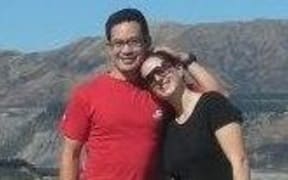An alpine rescue expert has told of having to abort an attempt to save two climbers standed on Mt Taranaki, despite knowing they were only 150 metres away.

Hiroki Ogawa and Nicole Sutton. Photo: NZ POLICE
Hiroki Ogawa and Nicole Sutton died of hypothermia when they became trapped near the summit in deteriorating weather during Labour Weekend last year.
Taranaki Alpine Cliff Rescue member Michael Johns told the an inquest into their deaths the hardest thing about aborting an attempt to save the couple was knowing they were only 150m away.
Mr Johns was in a group of five climbers which set off at 1am on the Sunday in an attempt to reach the couple. He told the coroner as they got higher, they experienced atrocious conditions, including high winds, sleet and ice, and two of the party turned back when one became unwell.
Mr Johns and the remaining rescuers eventually abandoned their bid to reach the trapped pair when getting down the mountain became a matter of personal safety.
GPS co-ordinates at the time indicated the rescuers were only 150m away from the couple, he said.
Earlier, the organiser of the fatal climbing trip told an inquest there was no designated leader on the expedition.
Rowan Smith told the coroner that the annual New Zealand Alpine Club climb was designed for members to network and develop climbing friendships, and had no designated leader.
The group had aimed to reach the summit of Mt Taranaki about midday and return to a lodge on the mountain in the late afternoon.
But the climbers with Mr Smith turned back at 4.20pm after getting reports of "hellish" conditions on the northern side of the mountain.
All of the climbers had lost track of the time.
New Zealand Alpine Club general manager Samuel Newton said the club was implementing safety processes following the deaths of Mr Ogawa and Ms Sutton.
It had commissioned an independent report into its safety management following the tragedy, which recommended introducing standardised trip guidelines and resources.
These included recording who was in the group, their abilities, the minimum equipment required, a trip leader checklist and emergency response plans.
Implementing the responsibilities of trip leaders would be a challenge for volunteers, who saw themselves as organisers rather than leaders, Mr Newton said.


